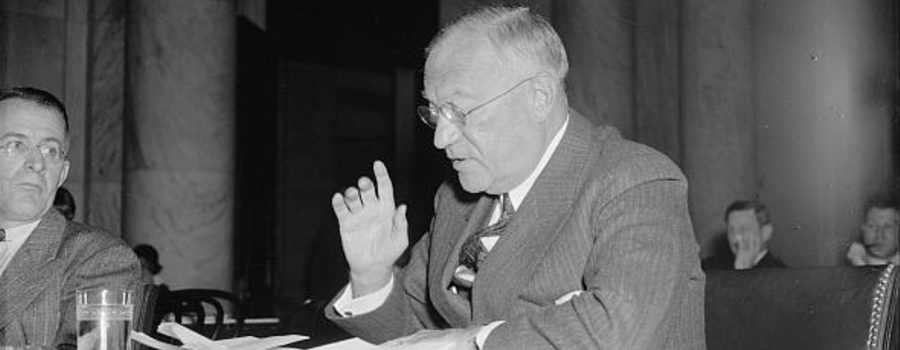
Photo: Senator Robert Wagner, testifying to his colleagues in 1938.
Introduced by Sen. Robert Wagner as S. 1161 to the 78th Congress (1943-1944). Companion legislation was filed by Rep. John Dingell the same session as H.R. 2861.
Index of Information on the Wagner-Murray-Dingell Bill
- Overview of the Wagner-Murray-Dingell Bill
- Introductory Remarks on the Wagner-Murray-Dingell Bill
- Articles on Wagner-Murray-Dingell
- Bibliography of Historical Writings on the Wagner-Murray-Dingell Bill
Overview of the Wagner-Murray-Dingell Bill
World War II significantly altered the politics of healthcare. As with most countries during the war, the U.S. government dramatically expanded its involvement in medical care, directly investing in medical schooling and hospital construction, expanding federally funded medical research, and providing medical care for soldiers and their families. Furthermore, when the draft was instituted in 1941, over 40 percent were found to be medically unfit for service.
In the United Kingdom, the government releases the "Beveridge Plan" in November 1942, a broad proposal for social insurance drafted by William Beveridge, who subsequently tours the United States in 1943. The Wagner-Murray-Dingell Bill of 1943 is explicitly based on the Beveridge report, and proposes a unified system of:
- National employment offices;
- Expansion of old-age insurance under Social Security;
- Survivors' insurance and death benefits;
- Permanent and temporary disability insurance;
- Unemployment insurance and unemployment allowances;
- Maternity benefits; and
- Medical and hospital insurance.
Unlike Wagner's 1939 proposal, this bill is the first to propose a nationally-administered health plan, including compulsory medical insurance for all employed workers and their dependents. The bill is supported by and drafted in part by the American Federation of Labor, which had opposed earlier versions of compulsory medical insurance. In 1944, labor joins with public health and social welfare advocates to form the Social Security Charter Committee, which lobbies on behalf of the bill.
This bill is characterized by its authors as a post-war measure, at a time when the cessation of war was still 2 years away and uncertain. The bill does not receive public hearings and, like Wagner's 1939 proposal, fails to receive the full backing of President Roosevelt.
Introductory remarks on the Wagner-Murray-Dingell Bill
Introduction of S. 1161 along with summary and Q&A as submitted by Senator Wagner to the Congressional Record on June 3, 1943:
 Loading...
Loading...
Talk delivered by Sen. James Murray to the Monroe County Medical Society on the Wagner-Murray-Dingell Bill, November 17, 1943:
 Loading...
Loading...
Articles on Wagner-Murray-Dingell
Fred Perkins articles published in the Washington News on the Wagner-Murray-Dingell bill, submitted by Senator Wagner to the Congressional Record on October 15, 1943:
 Loading...
Loading...
Albert Deutsch articles published in PM on the opposition organized against the Wagner-Murray-Dingell bill, submitted by Senator Wagner to the Congressional Record on March 13, 1944:
 Loading...
Loading...
Bibliography of Historical Writings on the Wagner-Murray-Dingell Bill
- Anderson, Odin W. "Compulsory Medical Care Insurance, 1910-1950," The Annals of the American Academy of Political and Social Science 273, Medical Care for Americans (Jan., 1951): 106-113.
- Derickson, Alan. "Health Security for All? Social Unionism and Universal Health Insurance, 1935-1958," The Journal of American History 80, no. 4 (Mar., 1994): 1333-1356.
- Falk, I. S. "Medical Care in the USA: 1932-1972. Problems, Proposals and Programs from the Committee on the Costs of Medical Care to the Committee for National Health Insurance," The Milbank Memorial Fund Quarterly. Health and Society 51, no. 1 (Winter, 1973), 1-32.
- Hirshfield, Daniel S. The Lost Reform: The Campaign for Compulsory Health Insurance in the United States from 1932 to 1943. Cambridge, MA: Harvard University Press, 1970.
- Huthmacher, J. Joseph. Senator Robert F Wagner and the Rise of Urban Liberalism. New York: Holiday House, 1971.
- Starr, Paul. “Transformation of defeat: the changing objectives of national health insurance, 1915-1980,” American Journal of Public Health 72, no. 1 (January 1, 1982): 78-88.
